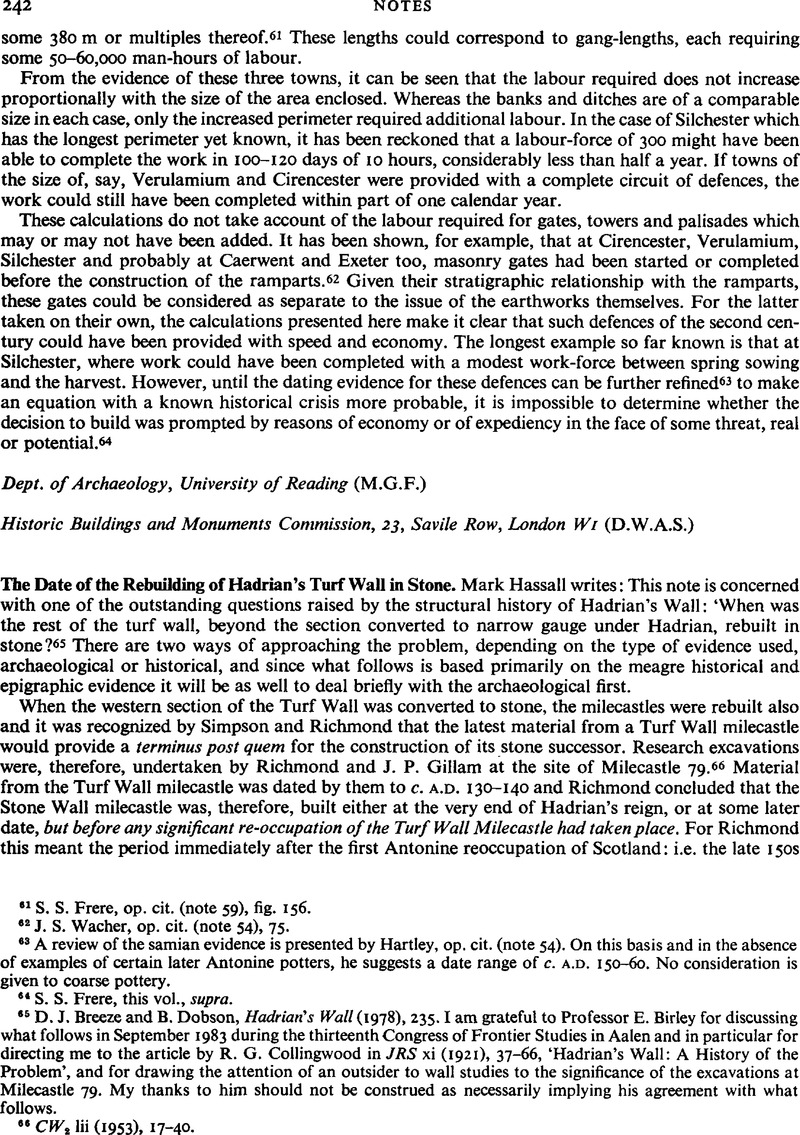Published online by Cambridge University Press: 09 November 2011

65 Breeze, D. J. and Dobson, B., Hadrian's Wall (1978), 235Google Scholar.I am grateful to Professor E. Birley for discussing what follows in September 1983 during the thirteenth Congress of Frontier Studies in Aalen and in particular for directing me to the article by Collingwood, R. G. in JRS xi (1921), 37–66, ‘Hadrian's Wall: A History of the Problem’, and for drawing the attention of an outsider to wall studies to the significance of the excavations at Milecastle 79. My thanks to him should not be construed as necessarily implying his agreement with what follows.Google Scholar
66 CW2 lii (1953), 17–40.Google Scholar
67 Daniels, C. M., Handbook to the Roman Wall, 13th edition (1978), 19, cf. p. 5.Google Scholar
68 ibid. 253, cf. Richmond, in the 12th edition of the Handbook, p. 207.Google Scholar
69 Gillam, J. P., Types of Roman Coarse Pottery Vessels in Northern Britain, 3rd edition (1970). The pottery from the Turf-Wall Milecastle 79 is dated group number 37.Google Scholar
70 The sources are conveniently collected by Collingwood, , op. cit. (note 65) 39–45Google Scholar, and by Mann, J. C., The Northern Frontier in Britain from Hadrian to Honorius: Literary and Epigraphic Sources (1971).Google Scholar
71 Breeze, and Dobson, , op. cit. (note 65) passim assume without question that the Wall ended at Turret 80b. The second edition of the Ordnance Survey map marks a hypothetical Turret 80a.Google Scholar
72 Usually translated nowadays as ‘after another wall, a turf one had been built’, but the Latin is more naturally translated as ‘after another turf wall had been built’, though the point should not be pressed. Cf. Collingwood, , op. cit. (note 65), p. 43 note.Google Scholar
73 Cf. Breeze, and Dobson, , op. cit. (note 65), p. 52–3Google Scholar, and Birley, E., Research on Hadrian's Wall (1961), 125.Google Scholar
74 The Teubner text of Eutropius prints CXXXIII (sic). For the actual MSS readings see Monumenta Gremaniae Historica Auctorum Antiquissimorum vol II: Eutropi Breviarium, ed. Droysen, H., (1961). One of the MS reads R XXXII M. P. which could account for the confusion. In Paianios' translation, printed in a parallel text by Droysen, it is already described as being 132 miles long. Paianios' is thought to have been used by Jerome for his expanded translation of Eusebius' Chronicle. At all events Jerome gives the distance also as CXXXII MP.Google Scholar
75 Monumenta Germaniae Historica, auctorum antiquissimorum vol XI Chronica Minora saec. iv-vii vol. II p. 145.
76 Though of course the consular date could refer to later work at the quarry than that undertaken for the initial reconstruction of the Turf Wall in stone. For an illustration of these quarry inscriptions see the thirteenth edition of the Handbook, p. 42. Birley, E., op. cit. (note 73), p. 126, draws attention to the single ‘centurial stone’ from the west end of the Wall (Wall-mile 79–80) RIB 2054, recording work by the third cohort of Legion II and its similarity to building records of the legion in Wall-miles 6/8 (e.g. RIB 1341–4, 1358–60). If the former is Severan this should indicate extensive repairs towards the east end of the Wall.Google Scholar